In the dynamic landscape of team collaboration, Slack has emerged as a pivotal platform for fostering communication, project management, and coordination of work. One of Slack’s lesser used super powers is its rich ecosystem of plugin apps, with one of the most popular ecological niches being leave and time off management. For those who are using or considering a tool like Vacation Tracker, read on to get a handle on what alternatives are out there and which option best fits your organizational needs!
AttendanceBot 
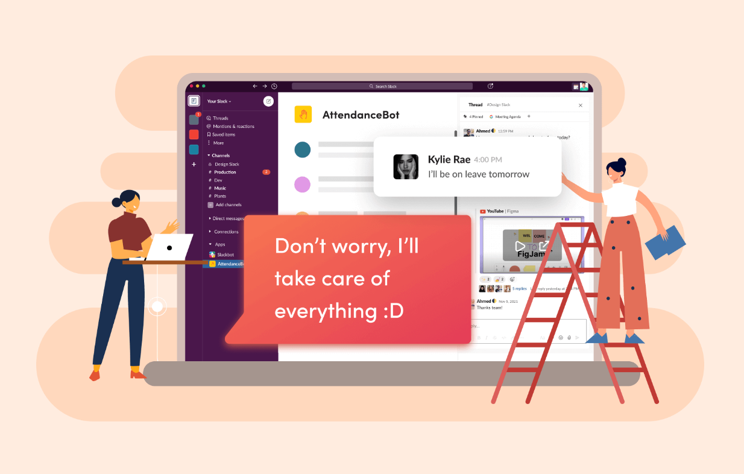
AttendanceBot remains the most popular choice since Slack launched its app store back in 2018. While some of its popularity stems from its one-stop-shop integration of time off, hybrid work, time tracking, project tracking, and shift rostering, it remains the go-to choice for leave management alone.
Designed for the type of organization that chooses and uses Slack, AttendanceBot is a great choice for small to mid-sized companies that value employee time and calendar visibility. If you’re growing fast and need a more sustainable leave process, looking to provide better transparency for calendars and balances, or just tired of managing everything with excel and email inboxes, AttendanceBot might be a good first step.
For small teams with simple needs, AttendanceBot offers a great off-the-shelf leave setup you can start using within minutes. With automatic manager routing and an option menu right inside Slack, you can start your team requesting and approving from the day you start, without any training or instruction. Even data and reports are available from directly in your Slack chat, without navigating over to the admin dashboard, and when in doubt – AttendanceBot has a shockingly responsive support team for its class of software.
For larger teams, international organizations, or really anyone with a complex leave policy, AttendanceBot shines particularly bright. One distinctive feature lies in its ability to configure rules and policies across employee groups, roles, and regions or countries. Given the ability to support accrual setups to match any set of local policies, AttendanceBot would almost be graded an enterprise-level software, though the laser-focus on time-off and timesheets typically makes it a better choice for departmental or operational deployments rather than a full global HR solution. Possibly for the same reason, AttendanceBot is still a popular choice for larger implementations exactly because it’s so quick to get off the ground and useful for a corporate workforce.
Price-wise, the design of AttendanceBot is often tempered by its ranking towards the high end of contenders. It has three pricing plans – standard, offering pretty much every piece of leave functionality except balances and accruals; pro, which adds in workforce segmentation, balance and accrual policies, and multi-level approvals; and premium, which adds extra layers of customization and support. The 14-day free trial is typically more than enough to explore and even pilot capabilities, especially given the high-level of free onboarding assistance offered by their team.
Overall, this vacation tracker alternative is a best first bet for its comprehensive abilities and forward-thinking design.
BambooHR 
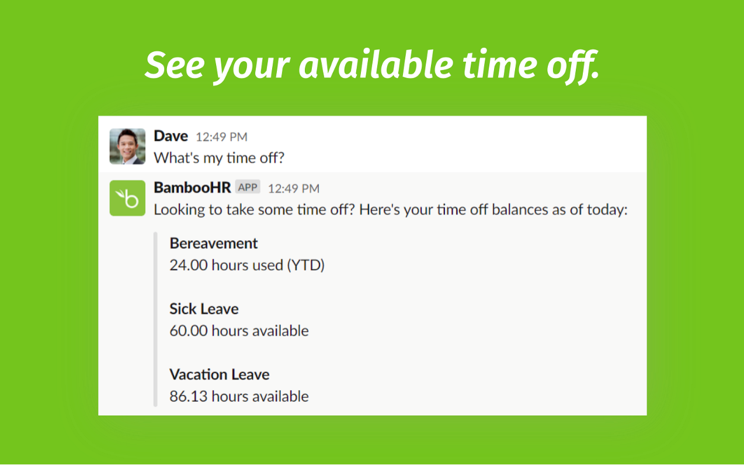
BambooHR is a fantastic full-service payroll and HR solution for small and medium-sized businesses. Offering a comprehensive suite of tools, BambooHR lots of options for managing HR tasks, from employee information management, recruiting and hiring, onboarding, leave management, performance management, and employee analytics.
While its integration with Slack is limited, BambooHR does bridge some of its most popular features into Slack. Specific to time-off, BambooHR allows team members to conveniently check available time-off balances, calculate future time-off balances, submit new time-off requests, and stay informed about current out-of-office status. Although the workflows for requesting leave may evoke a sense of traditional software, BambooHR remains a fully-featured and user-friendly tool, especially tailored for small businesses looking for a full HR solution.
Regards cost, BambooHR offers two primary plans that bill based on staff size – Essentials and Advantage. The Essentials plan covers basic HR tools, while the Advantage plan extends to additional features such as onboarding, offboarding, applicant tracking, etc. One limitation is the lack of free trial or onboarding support before making a purchase decision.
As a final plus, BambooHR uniquely offers its own marketplace of integration partners, and for those looking for the best possible end-user experience, there are plenty of paid plug-ins to experiment with (including the aforementioned AttendanceBot).
Calamari 
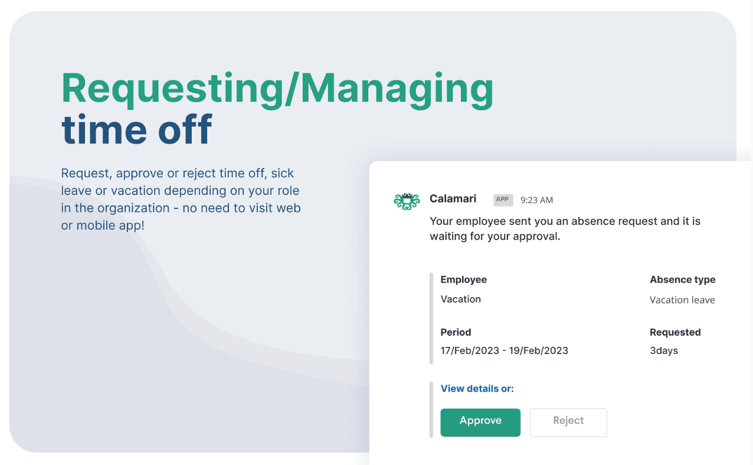
Calamari – like AttendanceBot – offers a bundled time tracking, time off, and employee documentation system. Calamari similarly facilitates easy planning and tracking of absences, while adding several functionalities on top of the leave basics offered by Vacation Tracker.
For those specifically interested in leave management, Calamari boasts an impressive range of integrations with other popular tools like JIRA, Asana, and Basecamp which are comparatively more rare among competitors. Calamari also allows for creation of flexible leave types, per the needs of each organization.
Unfortunately, despite a much wider range of functionality than Vacation Tracker, Calamari does have limited administrative and policy capabilities. Some users have found Calamari’s interface to be a bit less intuitive, with occasional descriptions of “clunky”.
Despite these considerations, Calamari remains an economical choice for teams. Calamari offer a nice pick and choose a-la-carte style pricing, with two plans and three modules to choose from. And for teams in the euro zone, Calamari offers payment in Euros instead of USD.
Timebot 
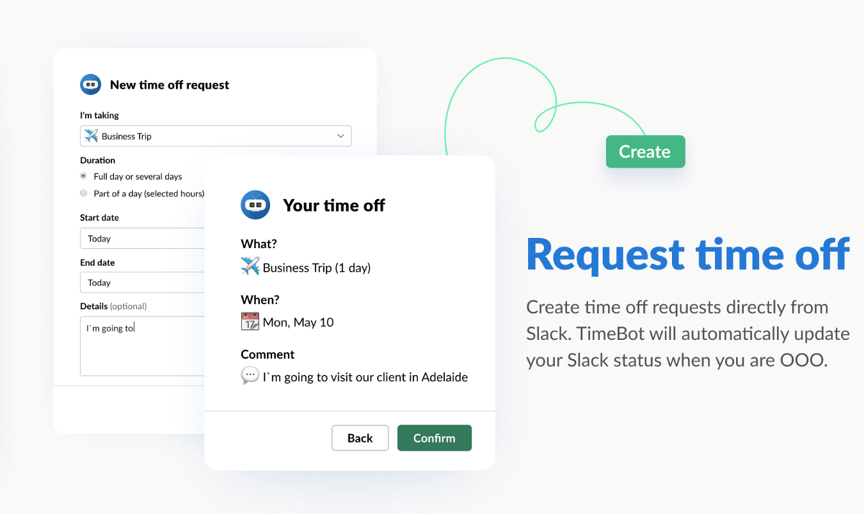
The most straightforward alternative for VacationTracker is TimeBot, with a similar but more limited set of features and pricing. If you like Vacation Tracker but want something even more barebones and lightweight, TimeBot might be your answer.
As another economical yet effective pick, TimeBot positions itself as the most budget-friendly option. TimeBot also has a free plan that’s limited to 20 time-off requests per month, which may be good for very small teams with modest needs. Otherwise, there are two paid options: the Starter plan at $1 per user per month and the Premium plan at $2.50 per user per month.
Time Off by Deel 
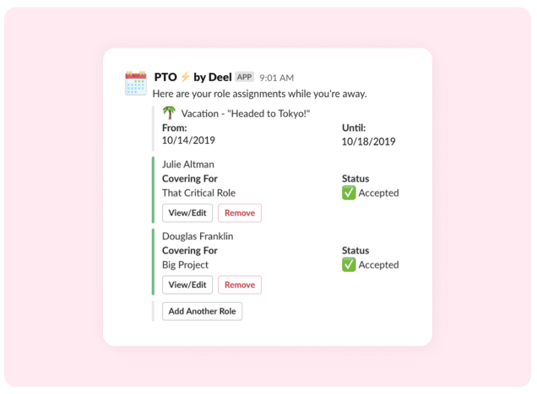
The Deel’s Engage plugins elevate productivity by enabling teams to complete tasks within Slack, minimizing the need for context-switching. This Slack vacation tracker alternative, Time Off by Deel, seamlessly integrates the process of requesting, tracking, and reviewing time off directly into Slack. A particularly valuable feature is the plugin’s ability to help managers stay informed about employee time-off balances, facilitating a proactive approach to recognizing signs of burnout. Additionally, the tool provides the functionality to assign coverage, ensuring that business operations continue smoothly during someone’s time away.
Time Off by Deel is an ideal choice for any Deel customer, and very seriously elevates the user experience of the Deel platform. As an emerging leader in global HR for startups and upstarts, Deel is another great choice for full-service HR, which offers a multitude of connected Slack plugins including time off.
If you’re thinking of biting the bullet on a full HR platform instead of Vacation Tracker, Deel is a fantastic option! But for those looking for more targeted or focused implementations, Deel might be a bit much.
Conclusion
These alternatives offer a diverse set of options to meet the evolving demands of modern workplaces, ensuring effective time-off management regardless what type of organization you are. The quest for the exact perfect alternative never truly ends, but hopefully this guide saves you time finding where you’d like to start.







